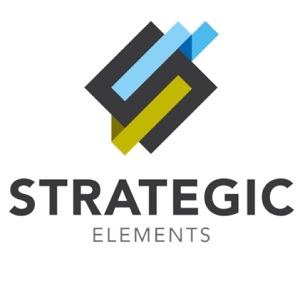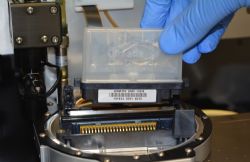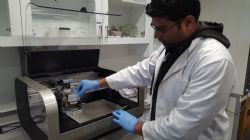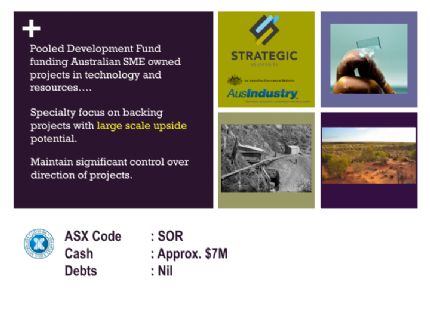 Development Breakthrough of Printable Nanocube Ink and New L
Development Breakthrough of Printable Nanocube Ink and New L
Sydney, Aug 25, 2015 AEST (ABN Newswire) - Strategic Elements ( ASX:SOR) is pleased to announce that its nanocube memory technology has been developed into printable ink. Additional patent coverage has been lodged over memory devices with a film or printable ink containing nanocubes. Work is now focused on optimising the nanocube ink to print memory cells using an inkjet printer onto silicon, glass and flexible plastic materials. SOR is backing the technology in its unique capital gains tax-free ASX listed structure.
ASX:SOR) is pleased to announce that its nanocube memory technology has been developed into printable ink. Additional patent coverage has been lodged over memory devices with a film or printable ink containing nanocubes. Work is now focused on optimising the nanocube ink to print memory cells using an inkjet printer onto silicon, glass and flexible plastic materials. SOR is backing the technology in its unique capital gains tax-free ASX listed structure.
The Company is also pleased to announce it has secured an exclusive global licence for UV light technology developed at UNSW targeting very large global markets in sensing, memory and IOT (Internet of Things). Information on the new licence follows the nanocube ink information below.
Significant Global Opportunity
Whilst printed electronics have reached mass production, the memory components of printed electronics are still very limited in their performance. Thus, a printable memory with high performance will be a breakthrough in printable electronics and assist in transforming the industry.
An outstanding feature (and clear point of difference) of the nanocube technology is the ability to be incorporated into a solution, which can potentially form printed, flexible and transparent memory cells with high performance and low power consumption.
The potential for a combination of high performance nanocube memory technology with low cost fabrication by printing creates significant global opportunities in a rapidly growing market segment. Leading research firm IDTechEx forecasts the total printed electronics market will grow from $16 billion in 2003 to $76.79 billion by 2023.
The Company believes there is no commercial ready printable memory with the potential of the nanocube memory technology.
Printable Ink Development
A research and development agreement has been signed with UNSW. Initial objectives over a 12-week timeframe are to further optimise the nanocube ink, develop printed memory prototypes and perform testing. Development success to date already includes:
1. A first batch of suspension solutions (nanocubes) has been prepared in the laboratory and successfully developed into printable ink. See images in link below.
2. The nanocube ink was successfully jetted from a commercial FujiFilm rapid prototyping inkjet printer onto both silicon and glass substrates.
3. The nanocube ink was transparent when printed onto glass. This opens up future potential applications to print the nanocube memory ink directly onto screens, displays and/or windows.
4. The nanocube ink contains billions of nanocubes printed in a film onto a substrate with individual nanocubes fabricated down to approximately 5 nanometres in size.
5. The nanocubes have been successfully engineered for near perfect self-assembly within the ink using a specific formulation. The self-assembly capacity can improve device performance.
Communication
The Company will progressively release information to the market over the course of the 12-week program as appropriate.
Nanocube ink optimisation, printing of memory cells onto silicon, glass and flexible plastic and testing for aspects such as programming speed and power consumption are all significant advancements. The program has already commenced.
Company Comment
Strategic Elements Managing Director Charles Murphy said, "Printed electronics to date have not found a solution for high performance printable memory. The 12-week program commenced at UNSW will show the world how cutting edge the nanocube technology is. The coming period will be quite a ride for the Company and its shareholders."
Why is Strategic Elements Different to Other Companies?
Most shareholders pay no capital gains tax when they sell their shares in ASX listed Strategic Elements. They also pay no tax on dividends they receive.
The Company has a special registration from the Federal Government as a Pooled Development Fund. It operates under a program designed to increase investment into Australian companies by providing government legislated tax incentives to Pooled Development Fund shareholders. Full information can be found on the Company website.
Commercial
A breakthrough in printed high performance memory could enable many new categories of electronic products. Companies have invested many billions of dollars into printable electronics and key technology companies have been identified for discussions on the nanocube technology.
Once testing is complete, the Company intends to approach certain companies to discuss development options to engage with the technical team from UNSW.
Printed Electronics
Wearable technologies, sensors, screens and displays, automotive markets, healthcare and 3D printing are creating strong market pull for printable electronics. New printing innovations take advantage of the same technologies used in actual printers, such as the print heads, ink, particle, and materials management capabilities. After many years of promise, printed electronics are moving into mass markets.
Manufacturing plants can potentially be built with one tenth to one hundredth of the capital cost of conventional semiconductor or thin-film fabrication plants. Devices can be produced in high volume over large areas on flexible substrates, thereby, enabling electronic systems to be deployed in a wide variety of non-traditional situations; on paper and plastic, on clothes, in furniture, cars and buildings, as well as on packaging and even in and on the human body.
According to industry innovation leaders Xerox, "the market for flexible and printed electronics is growing rapidly. The majority of this market growth will come from new markets enabled or disrupted by the use of flexible substrates, from low-cost printing of full-feature electronics, and from electronic devices integrated into novel systems or form factors."
The Nanocube Technology
The nanocube technology consists of tiny cube-shaped memory cells with potential to enable large amounts of data to be stored on smaller, faster memory devices. Nanocubes developed by the University of New South Wales are 10,000 times smaller than a human hair.
The technology is a new type of resistive random access memory (RRAM) using tiny nanocubes made from cerium oxides. The technology works by applying jolts of voltage to the nanocube memory cells, changing their state between resistive and conductive to create and store digital zeroes and ones (data).
UNSW has spent over two years developing the technology.
Parties Behind the Technology
100% owned Australian Advanced Materials (AAM) has an exclusive global license for the technology from UNSW and contracted the materials group at the UNSW School of Materials Science and Engineering to assist in development of a memory device prototype, make improvements to the nanocube memory technology and create new intellectual property.
The UNSW School of Materials Science and Engineering is ranked number 1 in Australia and number 26 in the world. The research group has received $20M in research grants since 2005, 45 researchers and $8M of world-class research equipment geared towards advanced materials.
Additional Technology Licence
The Company is also pleased to announce that a second technology licence has been signed with UNSW for development of patent pending UV light technology for markets including sensing and memory.
The technology exploits ultra-violet light as a new, additional method to control electronic device operations. The technology also has potential applications in IOT or the "Internet of Things".
The design has the capability to work as a memory and light sensor combination that opens the door to novel multifunctional storage devices.
A prototype was fabricated and laboratory testing conducted to date has demonstrated a reduction of power consumption by as much as 20% and a 10 times increase in data storage and processing speeds for high performance electronic devices.
Company Comment
Strategic Elements Managing Director Charles Murphy said, "Although the priority focus for the Company is on the nanocube technology, we are also keen to show the exceptional benefits of the UV light technology in its own right. Potential synergies between the two technologies will also be reviewed."
"The outstanding increase in speed and reduction in power is incredibly promising, as is the market potential of a combined sensor and memory device. We believe that once the potential of this technology is fully revealed, it will attract significant commercial interest."
Key Potential Benefits:
- Lower energy consumption
- Higher data storage capability
- Sustainable data storage at high fatigue levels and longer times
- Higher speed data processing and reduced heat dissipation
Potential Applications Include:
- Nano-electronic devices
- Replacement of existing flash memories
- Integrated light sensor-controlled devices
Key Terms of the Licence
100% owned Australian Advanced Materials (AAM) has been awarded an exclusive royalty-free global licence to the UV light technology and related intellectual property.
Within 3 years, AAM must show reasonable efforts to develop and exploit the technology. If AAM has shown reasonable efforts to conduct these activities, UNSW will assign its right, title and interest in the technology.
Additional information will also be released on the UV light technology this week.
To view the images, please visit:
http://media.abnnewswire.net/media/en/docs/ASX-SOR-731000.pdf
About Strategic Elements Ltd
 Strategic Elements (ASX:SOR) shares are listed on the Australian Stock Exchange under the code “SOR”. The Company is registered under the Pooled Development Program run by the Australian Federal Government to encourage investment into SME’s. To assist Pooled Development Fund’s to invest and raise capital, the Federal Government enables most shareholders in a Pooled Development Fund to make capital gains and receive dividends tax-free.
Strategic Elements (ASX:SOR) shares are listed on the Australian Stock Exchange under the code “SOR”. The Company is registered under the Pooled Development Program run by the Australian Federal Government to encourage investment into SME’s. To assist Pooled Development Fund’s to invest and raise capital, the Federal Government enables most shareholders in a Pooled Development Fund to make capital gains and receive dividends tax-free.
![abnnewswire.com]()
Related Companies
Social Media
Share this Article

 ASX:SOR) is pleased to announce that its nanocube memory technology has been developed into printable ink. Additional patent coverage has been lodged over memory devices with a film or printable ink containing nanocubes. Work is now focused on optimising the nanocube ink to print memory cells using an inkjet printer onto silicon, glass and flexible plastic materials. SOR is backing the technology in its unique capital gains tax-free ASX listed structure.
ASX:SOR) is pleased to announce that its nanocube memory technology has been developed into printable ink. Additional patent coverage has been lodged over memory devices with a film or printable ink containing nanocubes. Work is now focused on optimising the nanocube ink to print memory cells using an inkjet printer onto silicon, glass and flexible plastic materials. SOR is backing the technology in its unique capital gains tax-free ASX listed structure. Strategic Elements (ASX:SOR) shares are listed on the Australian Stock Exchange under the code “SOR”. The Company is registered under the Pooled Development Program run by the Australian Federal Government to encourage investment into SME’s. To assist Pooled Development Fund’s to invest and raise capital, the Federal Government enables most shareholders in a Pooled Development Fund to make capital gains and receive dividends tax-free.
Strategic Elements (ASX:SOR) shares are listed on the Australian Stock Exchange under the code “SOR”. The Company is registered under the Pooled Development Program run by the Australian Federal Government to encourage investment into SME’s. To assist Pooled Development Fund’s to invest and raise capital, the Federal Government enables most shareholders in a Pooled Development Fund to make capital gains and receive dividends tax-free.








